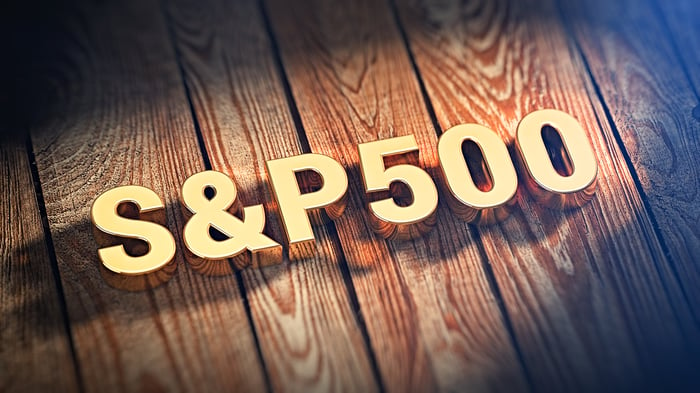What's the S&P 500 going to do in 2017? It's a question we'd all love the answer to, as it can inform financial decisions we make throughout the year. If it's going to drop, for example, we might want to sell some or many holdings now. If it's going to rise, we can relax and perhaps buy more stocks. Unfortunately, though, despite what many financial pundits suggest, no one can know just what the S&P 500 will do next year.

Image source: Getty Images.
History lesson
A look at past years is informative. They show that even when you might be rather sure that the market is overheated and has gotten ahead of itself, making a pullback likely, it can continue rising. Here are some past years' returns:
|
Year |
S&P 500 Return |
|---|---|
|
1993 |
9.97% |
|
1994 |
1.33% |
|
1995 |
37.20% |
|
1996 |
22.68% |
|
1997 |
33.10% |
|
1998 |
28.34% |
|
1999 |
20.89% |
|
2000 |
(9.03%) |
|
2001 |
(11.85%) |
|
2002 |
(21.97%) |
|
2003 |
28.36% |
|
2004 |
10.74% |
|
2005 |
4.83% |
|
2006 |
15.61% |
|
2007 |
5.48% |
|
2008 |
(36.55%) |
|
2009 |
25.94% |
|
2010 |
14.82% |
|
2011 |
2.10% |
|
2012 |
15.89% |
|
2013 |
32.15% |
|
2014 |
13.52% |
|
2015 |
1.36% |
Data source: Professor Aswath Damodaran, New York University.

Image source: Getty Images.
Trying to imagine what investors (especially naive ones) might have been thinking in various years -- without the benefit of hindsight -- can be enlightening. For example, if you were invested in 1993 and 1994 and saw returns in the single digits, you might have had low expectations for the next few years. But look at 1995! The market shot up by close to 40%! That was followed by another banner year, with a rise of nearly 23% in 1996. Those two years alone would have turned a $1,000 investment into $1,683! It would seem quite reasonable, then, to expect a pullback in 1997, but instead we got an even bigger climb, of 33%, followed by two more years of gains topping 20%.
Then, in 2000, 2001, and 2002, there were three years of declines, and increasingly large ones. That would have put many people off of stocks, but the following year saw a big bounce. From 2003 to the present, the S&P 500 only had one bad year -- though it was a doozy, with a drop of close to 37% in 2008.
How is the S&P 500 doing in 2016? Well, as of Dec. 14, it was up 12.6%.
The dangers of market timing
After that history lesson, and considering that the market hasn't had a down year in a long time, you may still be tempted to expect a drop in 2017. It certainly might happen. But it might not, too. So if you sell in preparation for a drop, you might end up on the sidelines during another big run -- at which time you really won't want to buy back into the market as it will seem even more like it's due to drop.
A 2008 commentary from the folks at SEI illustrated this with numbers:
|
Strategy, 1926-2007 |
Annualized Return |
Growth of $100,000 |
|---|---|---|
|
Exit when market declines; Stay out until market has a decent year |
8.4% |
$72.6 million |
|
Exit when market is "too high"; Stay out until after a down year |
8.3% |
$70.7 million |
|
Remain invested through ups and downs |
10.4% |
$323.9 million |
Data source: SEI.

Image source: Getty Images.
Remaining invested can be easier said than done, though, as we often act on our emotions, not our reasoning. Data from Dalbar & Lipper offer another example of just how destructive our emotions can be to our wealth. Between 1996 and 2015, stock mutual funds averaged annual gains of 7.7%. That's enough to turn a single $10,000 investment in 1996 to $44,000 by the end of 2015. Amazingly, though, the average annual gain of the average stock mutual fund investor was just 4.7% over the same period. Growing at 4.7% annually over 20 years, a $10,000 investment will become...$25,000, fully $19,000 less. Why the difference? Well, it reflects investors selling out of their funds when afraid and jumping back in when greedy. The bigger gain was realized only by those who sat put. Trading in and out of stocks or funds can also rack up commission costs and can lead to short-term gains, which are generally taxed at higher rates than long-term gains.
Remember, all market crashes have been followed by recoveries. Check out this graph that Morgan Housel offered last year:

Image source: Morgan Housel.
What to do
So what should you expect from the S&P 500 in 2017? Well, expect anything. Prepare to hang on if the market surges -- though you might sell some holdings if they simply seem very overvalued -- and to hang on if the market tanks. In fact, a market crash offers excellent entry points for many stocks, so prepare to snap up some stocks on your wish list, should the S&P 500 crash in 2017.
In the meantime, keep only your long-term money in stocks, as you don't want to have to make withdrawals during a bear market.




